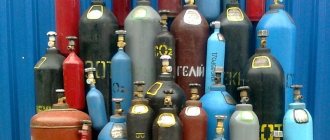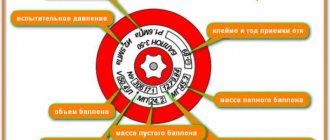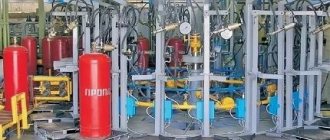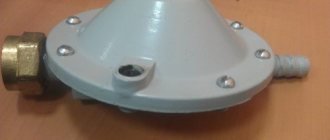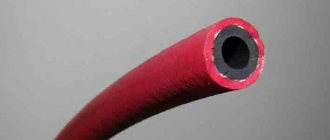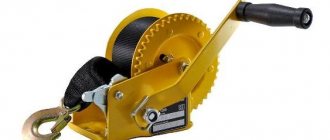Steel cylinders are used for storing and transporting compressed, liquefied and dissolved gases under pressure . Cylinders have different capacities - from 0.4 to 55 dm3.
Cylinders are steel cylindrical vessels, in the neck of which there is a conical hole with a thread into which a shut-off valve is screwed. Each gas has its own valve designs, which excludes the installation of oxygen valves on an acetylene cylinder and vice versa. A ring with an external thread is tightly fitted onto the neck to screw on a safety cap, which serves to protect the cylinder valve from possible shocks during transportation.
Cylinders for compressed, liquefied and dissolved gases are made from seamless carbon and alloy steel pipes. For liquefied gases at an operating pressure of not more than 3 MPa, the use of welded cylinders is allowed.
Depending on the type of gas contained in the cylinder, the cylinders are painted on the outside in conventional colors, and the name of the gas is also applied with paint corresponding to each gas. For example, oxygen cylinders are painted blue, and the inscription is made with black paint, acetylene - in white and red paint, hydrogen - in dark green and red paint, propane - in red and white paint. Part of the upper spherical part of the cylinder is not painted and the passport data of the cylinder is stamped on it: type and serial number of the cylinder, trademark of the manufacturer, weight of the empty cylinder, capacity, operating and test pressure, date of manufacture, quality control department stamp and Gosgortekhnadzor inspection stamp, next date tests. Cylinders are periodically, every five years, inspected and tested.
The main types of cylinders used for storing and transporting oxygen, nitrogen, hydrogen and other gases are shown in the table.
Oxygen cylinders
For gas welding and cutting, oxygen is delivered in steel oxygen cylinders of type 150 and 150 L. The oxygen cylinder is a steel seamless cylindrical vessel 3, having a convex bottom 1, onto which a shoe 2 is pressed; At the top, the cylinder ends with a neck 4. The neck has a conical hole into which a shut-off valve 5 is screwed in. A safety cap 6 is screwed onto the neck to protect the valve.
The most widely used for gas welding and cutting are cylinders with a capacity of 40 dm3. These cylinders have the following dimensions: outer diameter - 219 mm, wall thickness - 7 mm, height - 1390 mm. The weight of the cylinder without gas is 67 kg. They are designed for a working pressure of 15 MPa, and a test pressure of 22.5 MPa.
To determine the amount of oxygen in the cylinder, you need to multiply the capacity of the cylinder (dm3) by the pressure (MPa). For example, if the capacity of a cylinder is 40 dm3 (0.04 m3), pressure is 15 MPa, then the amount of oxygen in the cylinder is 0.04x15 = 6 m3.
Figure 1 — Oxygen cylinder
At the welding station, the oxygen cylinder is installed in a vertical position and secured with a chain or clamp. To prepare an oxygen cylinder for operation, unscrew the cap and fitting plug, inspect the valve to determine if there is any grease or oil on it, carefully open the cylinder valve and blow through its fitting, then close the valve, inspect the union nut of the reducer, attach the reducer to the cylinder valve , set the operating oxygen pressure with the adjusting screw of the gearbox. When you finish withdrawing gas from the cylinder, you must ensure that the residual pressure in it is not less than 0.05-0.1 MPa.
When handling oxygen cylinders, it is necessary to strictly observe operating and safety rules, which is due to the high chemical activity of oxygen and high pressure. When transporting cylinders to the welding site, you must firmly remember that it is prohibited to transport oxygen cylinders together with flammable gas cylinders. If the oxygen cylinder valve freezes, you need to warm it up with a rag soaked in hot water.
The reasons for the explosion of oxygen cylinders may be contact with fat or oil on the valve, falling or hitting the cylinders, the appearance of a spark when too much gas is drawn off (the neck of the cylinder is electrified), heating of the cylinder by some heat source, as a result of which the gas pressure in the cylinder will become higher than permissible.
Table 1 - Types of cylinders for liquefied gases
| Cylinder type | Pressure, MPa | Tensile strength, MN/m2 | Relative extension, % | ||
| conditional | hydraulic | pneumatic | |||
| 100 | 10 | 15,0 | 10 | 650 | 15 |
| 150 | 15 | 22,5 | 15 | 650 | 15 |
| 200 | 20 | 30,0 | 20 | 650 | 15 |
| 150L | 15 | 22,5 | 15 | 900 | 10 |
| 200L | 20 | 30,0 | 20 | 900 | 10 |
Safety precautions
The oxygen cylinder design is very simple, but reliable. The main thing is to accurately observe the parameters of the gas pumped inside so that the container does not rupture. During operation and storage, some very strict requirements must be observed.
- If an oxygen cylinder is used in a stationary welding station, then it is installed vertically and secured with a rigid clamp.
- Before installation, the gearbox must be inspected for the absence of grease and oil stains.
- The fitting must be purged, after which the gearbox itself is screwed on.
- After complete extraction of gas, it is necessary to leave some oxygen inside under a minimum pressure of 0.5 kg/cm². The reason is so that filling stations can analyze previously filled gas and compare it with what is available.
- Oxygen must not be transported with other flammable gases.
- At sites, oxygen cylinders must be transported in special trolleys on soft rubber wheels.
- The distance from the installed oxygen container to an open flame source or welding machine is at least 5 meters.
- There must be protection from precipitation and sunlight during prolonged use outdoors.
- If the valve of an oxygen cylinder is frozen, then it should only be thawed with a clean rag soaked in hot water.
- Cylinders should be stored in metal boxes with holes; a lock must be attached.
- A small cylinder must be carried in a special metal box, which is equipped with a handle and a strap for carrying on the shoulder.
Refilling with oxygen is a complex process, because it is the gas that is pumped into the welding cylinders. And it reaches the distribution station in a liquid state. Such oxygen is much safer than gaseous oxygen, but it evaporates quickly and in large quantities, which is not profitable financially. But manufacturers take such losses because safety comes first. Moreover, liquid oxygen is transported in large quantities (road and rail tanks). If such a volume catches fire and explodes, the losses will be several times greater.
Gas is pumped into cylinders using pumping and pumpless methods. In this case, filling does not occur with supercooled oxygen. When performing any actions with a cylinder, it is very important to comply with accuracy and safety requirements. The most vulnerable point is the valve; most often it is the valve that fails because it is subjected to repeated opening and closing.
It cannot be repaired, you can only replace it with a new one. Doing this with your own hands is prohibited; such an operation can only be carried out in a factory setting. Here it is important to follow the installation rules, which are based on pressing, that is, screwing in under a certain pressure. Then the cylinder itself with the valve is checked with test pressure. By the way, testing is hydraulic. Water is pumped inside the cylinder under a pressure of 225 or 300 kg/cm², which remains there for 5 minutes. After which the pressure is reduced to working pressure - 150 or 200 kg/cm².
It should be noted that the same technology is used to check the cylinders themselves to detect leaks. If nothing is found: all joints and walls have not become wet, then the test was successful and the device itself can be used further.
Acetylene cylinders
Powering gas welding and cutting stations with acetylene acetylene cylinders is now widespread They have the same dimensions as the oxygen one. An acetylene cylinder is filled with a porous mass of activated charcoal (290-320 g per 1 dm3 of cylinder capacity) or a mixture of coal, pumice and infusorial earth. The mass in the cylinder is impregnated with acetone (225-300 g per 1 dm3 of cylinder capacity), in which acetylene dissolves well. Acetylene, dissolving in acetone and being in the pores of the porous mass, becomes explosion-proof and can be stored in a cylinder under a pressure of 2.5-3 MPa. The porous mass must have maximum porosity, behave inertly towards the metal of the cylinder, acetylene and acetone, and not produce sediment during operation. Currently, (GOST 6217-74) with a grain size from 1 to 3.5 mm is used as a porous mass Acetone (chemical formula CH3COCH3) is one of the best acetylene solvents; it impregnates the porous mass and dissolves it when filling cylinders with acetylene. Acetylene delivered to consumers in cylinders is called dissolved acetylene.
Figure 2 - Acetylene cylinder
The maximum acetylene pressure in the cylinder is 3 MPa. The pressure of acetylene in a fully filled cylinder changes with temperature:
| Temperature, °C | -5 | 0 | 5 | 10 | 15 | 20 | 25 | 30 | 35 | 40 |
| Pressure, MPa | 1,34 | 1,4 | 1,5 | 1,65 | 1,8 | 1,9 | 2,15 | 2,35 | 2,6 | 3,0 |
The pressure of filled cylinders should not exceed 1.9 MPa at 20°C.
When the valve of the cylinder is opened, acetylene is released from the acetone and enters in the form of a gas through the reducer and hose into the burner or cutter. Acetone remains in the pores of the porous mass and dissolves new portions of acetylene during subsequent fillings of the cylinder with gas. To reduce acetone losses during operation, it is necessary to keep acetylene cylinders in a vertical position. At normal atmospheric pressure and 20°C, 28 kg (l) of acetylene are dissolved in 1 kg (l) of acetone. The solubility of acetylene in acetone increases approximately in direct proportion with increasing pressure and decreases with decreasing temperature.
To fully utilize the cylinder capacity, it is recommended to store empty acetylene cylinders in a horizontal position , as this promotes uniform distribution of acetone throughout the entire volume, and with the valves tightly closed. When acetylene is removed from the cylinder, it carries away some of the acetone in the form of vapor. This reduces the amount of acetylene in the cylinder during subsequent fillings. To reduce the loss of acetone from the cylinder, acetylene must be withdrawn at a rate of no more than 1700 dm3/h.
To determine the amount of acetylene , the cylinder is weighed before and after filling with gas and the amount of acetylene in the cylinder in kg is determined from the difference.
Example. The mass of the cylinder with acetylene is 89 kg, empty - 83 kg, therefore, the amount of acetylene in the cylinder is equal to: by weight - 89-83 = 6 kg, by volume - 6/1.09 = 5.5 m3 (1.09 kg/m3 - density of acetylene at atmospheric pressure and temperature 20°C).
The mass of an empty acetylene cylinder consists of the mass of the cylinder itself, the porous mass and acetone. When taking acetylene from a cylinder, 30-40 g of acetone per 1 m3 of acetylene is consumed along with the gas. When removing acetylene from a cylinder, it is necessary to ensure that the residual pressure in the cylinder is at least 0.05-0.1 MPa.
The use of acetylene cylinders instead of acetylene generators provides a number of advantages : compactness and ease of maintenance of the welding installation, safety and improved working conditions, increased productivity of gas welders. In addition, dissolved acetylene contains fewer impurities than acetylene obtained from acetylene generators.
The reasons for the explosion of acetylene cylinders can be sudden shocks and impacts, strong heating (over 40°C).
Types of welding mixtures
Argon . Argon is used for argon arc welding. This gas is used for welding workpieces made of high-alloy steels, copper, aluminum, cast iron, titanium, and silver.
Carbon dioxide . To weld stainless steel workpieces, a balloon welding mixture based on carbon dioxide is used. For example, when hydrogen is added to the gas mixture, the welding process is significantly accelerated. Oxygen and hydrogen in a carbon dioxide cylinder range from 10 percent. When performing plasma cutting, 25-45 percent hydrogen is added to the mixture to increase power.
Nitrogen . This chemical element is used in gas mixtures to join workpieces made of copper, silver, and their alloys, increases corrosion resistance, and reduces the presence of iron in carbon deposits. But when using nitrogen mixtures, TIG electrodes wear out faster.
To perform MIG and MAG welding, two-component gas mixtures (5% oxygen), three-component mixtures (oxygen-2.5%, CO2 -20%, argon-75%) are used. This composition makes it possible to avoid burnout and splashing of alloying components.
For welding work, two cylinders are used simultaneously: with argon and carbon dioxide or oxygen and carbon dioxide.
Advantages of using balloon welding mixtures
- Improved working conditions
- High stability
- Minimizing post-processing of welded products
- Saving consumables
- Improved welding quality
- The total cost of welding work is significantly lower
Cylinders for pronan-butane
Propane-butane cylinders are manufactured in accordance with GOST 15860-84 welded from sheet carbon steel. The main application was found in cylinders with a capacity of 40 and 50 dm3. Propane-butane cylinders are painted red with the word “propane” written in white.
A cylinder for propane-butane is a cylindrical vessel 1, to the top of which a neck 5 is welded, and to the bottom - a bottom 2 and a shoe 3. A brass valve 6 is screwed into the neck. Backing rings 4 are pressed onto the cylinder body. A cap is used to protect the cylinder valve 7.
The cylinders are designed for a maximum pressure of 1.6 MPa. Due to the high coefficient of volumetric expansion, cylinders for liquefied gases are filled to 85-90% of the total volume. for propane cylinders 24 kg of liquid propane-butane is poured into a cylinder with a capacity of 55 dm3. The maximum gas extraction should not exceed 1.25 m3/h.
Figure 3 — Prop-butane cylinder
Equipment
The main additional element of the oxygen tank is the valve. It is made from brass. A protective cap must be installed over the valve; it can be aluminum or plastic. Usually the cap comes as an integral part. But they are often lost, so the protective device can be made from any material with your own hands. Reliability and tightness are important here. The valve is screwed into the cylinder itself using a conical thread
The second most important element is the shoe. It is on him that the entire weight load falls. It is made from steel strip, which is shaped into a square cross-section. GOST does not define exactly how it should be fixed to the cylinder, so some manufacturers weld it, others press it in.
Storage and transportation of cylinders
Transportation of cylinders is permitted only on spring vehicles, as well as on special hand carts or stretchers. When transporting containers without containers, the following requirements must be met:
- All cylinders must have safety caps screwed on completely;
- oxygen cylinders must be placed in wooden sockets (it is allowed to use metal linings with sockets covered with rubber or other soft materials);
- oxygen cylinders should only be laid across the body of the car so that the safety caps are on one side; it is allowed to lay cylinders within the height of the sides;
- cylinders must be loaded by workers who have undergone special training.
Transportation of oxygen and acetylene cylinders in a vertical position is allowed only in special containers. The combined transportation of oxygen and acetylene cylinders on all types of transport is prohibited, with the exception of transporting two cylinders on a special trolley to the workplace. In summer, cylinders should be protected from sunlight with a tarpaulin or other covering. Cylinders within the workplace may be moved by tilting in an inclined position. At workplaces, cylinders must be firmly secured in a vertical position.
How oxygen containers are made
Oxygen cylinders are produced from seamless pipes. They are divided into segments, after which the ends of each workpiece are heated and rotary seaming is performed. Then the products are hardened, during which they become strong and acquire the necessary flexibility. This is followed by grinding the surface of the cylinder, the product is subjected to high pressure testing, then painted, labeled and dried. After drying, compressed oxygen can be pumped into the container.
Requirements for marking gas cylinders according to GOST R ISO 14175
In order not to be misleading, we clarify that this marking has nothing to do with the data that must be indicated on the spherical part of each cylinder in accordance with regulatory documents for equipment operating at excess pressure (the date of the next technical inspection, the mark of the organization that carried out technical examination, etc.).
So, each vessel or gas cylinder must have a tag or label attached to it, which must contain the following information:
- name of manufacturer or supplier
- trademark
- gas designation according to standard
- health warnings
- safety warning
Scope of use
Compressed oxygen is a popular gas, the scope of which depends on the type of raw material. The medical substance is used during the resuscitation of patients. The element has a beneficial effect on the heart and lungs, so therapeutic procedures are often prescribed for health problems. The component is taken to saturate cocktails during oxygen starvation.
Technical gas heats up quickly and maintains high temperatures for a long time. The resulting continuous jet burns through metal of any density, which allows you to cut or solder parts. The characteristic is useful both in construction and in domestic use. In metallurgy, the substance increases the efficiency of furnaces, thereby improving the quality of the finished product.
In the chemical industry they are used in the production of complex acids and explosives. In the pulp industry, paper is cleaned and bleached with oxygen; in the fish industry, ponds are enriched. In aviation, gas is involved in the oxidation of motor fuel.
4. TEST METHODS
4.1. Pneumatic and hydraulic pressure tests are carried out in accordance with the “Rules for the design and safe operation of pressure vessels.” Test duration is at least 1 minute. Pneumatic tests of cylinders intended to be filled with gases, the penetrating ability of which is higher than that of air, must be carried out in accordance with regulatory and technical documentation.
(Changed edition, Amendment No. 4).
4.2; 4.3. (Excluded, Amendment No. 4).
4.4. Cylinders equipped with a chlorine valve are tested with a pneumatic pressure equal to 2.94 (30 kgf/cm2).
4.5. Tensile test according to GOST 10006-80. The test speed up to the yield point and during its passage is no more than 10 mm/min, beyond the yield point is no more than 40 mm/min. It is allowed to control the mechanical properties of carbon steel cylinders using a non-destructive method according to the regulatory and technical documentation. In controversial cases, tests are carried out in accordance with GOST 10006-80.
4.6. Impact bending test - according to GOST 9454-78 on longitudinal samples of type 3.
4.7. If the test results do not comply with the requirements of this standard, tests are carried out on twice the number of samples.
If the results of repeated tests are unsatisfactory, the entire batch of cylinders is sent a second time for heat treatment.
No more than two repeated heat treatments are allowed. Additional tempering is not considered repeated heat treatment.
(Changed edition, Amendment No. 4).
4.8. The volume of the cylinder must be controlled by limiting templates along the length; in this case, the volume of the cylinder should not be lower than the nominal one. The volume of two cylinders from a batch is checked by filling with water and determining the volume or mass of water.
Note. From 01/01/89, determination of the volume of all medium-volume cylinders is introduced.
(Changed edition, Amendment No. 1, 2).
Application area
Oxygen in cylinders for welding is used in many areas of industry. Almost all places where semi-automatic or gas welding is used require the use of oxygen. With its help, gas-flame processing of metal is carried out, both before and after welding.
If we consider the use of gas for cutting, then it becomes integral, since it is it that gives the high temperature of the jet, which burns through metal products. The minimum acceptable oxygen purity for oxygen use in welding is 99.2%. It is better if this figure is higher when it comes to important work. For home use, there are budget options and 92% oxygen.
Pressure of oxygen or argon in a fully charged cylinder depending on temperature
To properly use gas in cylinders, it is worth knowing the pressure of its various types, indicating the temperature. For greater clarity, we have presented such data in the form of a table below.
| Pressure | Temperature |
| 105 kgf/cm2 | -40 °C |
| 120 kgf/cm2 | -20 °C |
| 135 kgf/cm2 | 0 °C |
| 150 kgf/cm2 (nominal) | +20 °C |
| 165 kgf/cm2 | +40 °C |
Gearbox
To work with any gas you need a reducer. There are models that simply show the pressure in the cylinder and with the function of regulating the gas flow.
The latter types are called regulators. They are adapted to a specific gas, painted in accordance with the color of the cylinder. There are regulators with dial scales and rotameters on sale.
If you plan to carry out argon arc welding, you need to take a regulator with two rotameters. When working with stainless steel, you need air blowing from the reverse side, which only this regulator model can control.
In other situations, a dial regulator is quite suitable, which also costs less. Practitioners consider the switch model to be more economical. If used correctly, it allows you to avoid pressure release at the beginning of work. On regulators with rotators, pressure release at first is almost inevitable. This is accompanied by some gas losses.
All regulators have gaskets made of inert polymers. Gas contamination from contact with them is absolutely excluded. When welding you have to use different gases. For such production applications, it is advisable to have regulators suitable for several types of threads.
Coloring
For safety purposes, strictly defined coloring of containers and inscriptions on it have been introduced. The gases most commonly used in cooking are color coded as follows:
- The highly purified argon cylinder is gray in color and has a green inscription on it. The black cylinder with technical argon has a blue inscription. There is also so-called raw argon with its own markings. This gas is not used in welding;
- carbon dioxide cylinders are painted black, the inscription on them is in yellow;
- oxygen cylinders for welding are always blue, and the inscriptions on them are black. Both medical and technical grades of gas are colored this way. In medicine, oxygen is used very often. It is transported on trolleys, then, if necessary, the cylinder is installed in a special case;
- containers containing acetylene, which is very popular in welding, are black in color. Acetylene explodes very easily. Therefore, it is not pumped into empty volumes, but containing special fillers with a large number of pores. This filling method significantly reduces the likelihood of explosions.
Safety
The peculiarity of the domestic mentality is the tendency to save money and ignore many regulatory requirements. When it comes to welding equipment, neglecting safety rules can have serious consequences.
This is especially true for the permissible periods of use of cylinders. They must be specified by the manufacturer. If suddenly this information is not available, then the maximum period of operation is 20 years.
An examination of the condition of ordinary cylinders with a volume of up to 50 liters is not carried out. For larger volumes, certification can be carried out. It is strictly forbidden to exceed the maximum period. All models produced before 1997 that have not passed certification can be safely scrapped.
The purchase of gas cylinders for welding should be taken very seriously. It is best to find a reputable supplier, make sure that permits are available, and check the quality of the labeling and all accompanying information. After this, you can safely place your order.
Types of gases
Gases used in welding are divided into active and inert, among the active there are reactive and neutral. Moreover, the active gas can be reactive under some conditions and types of welding, and neutral under others.
All of them are pumped into special welding cylinders. Before ordering gas for work, you should familiarize yourself with the types of standard markings, the possibility of subsequent filling of cylinders with welding mixture, and their equipment.
All gases are pumped into cylinders under pressure . Therefore, containers are made of steel that does not have seams. Only at a pressure less than 3 MPa can gas containers be welded or have a seam.
In welding practice, such types are not found. Gases for welding are supplied only in cylinders without seams with special shut-off valves. Fundamentally different valves are designed for different gases.
Cylinders with gaseous flammable hydrocarbons - acetylene, propane, butane and others - are equipped with valves with left-hand threads.
Cylinders with all other gases, including oxygen, nitrogen, carbon dioxide and inert gases, are equipped with valves with right-hand threads.
The difference in the directions of rotation of the valve eliminates the possibility of accidental errors, accidents during welding or other use of gas.

